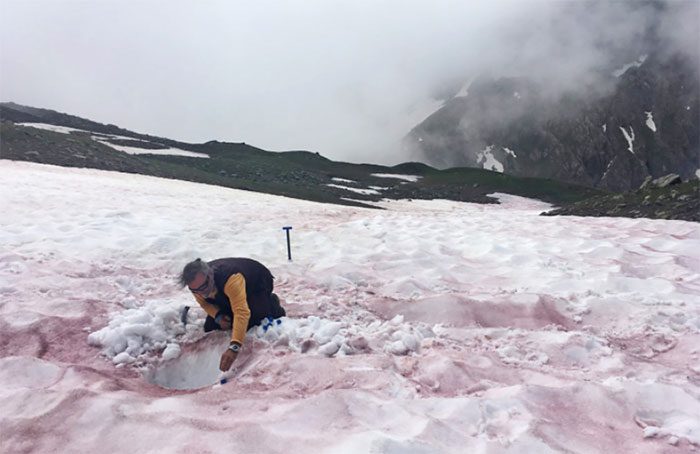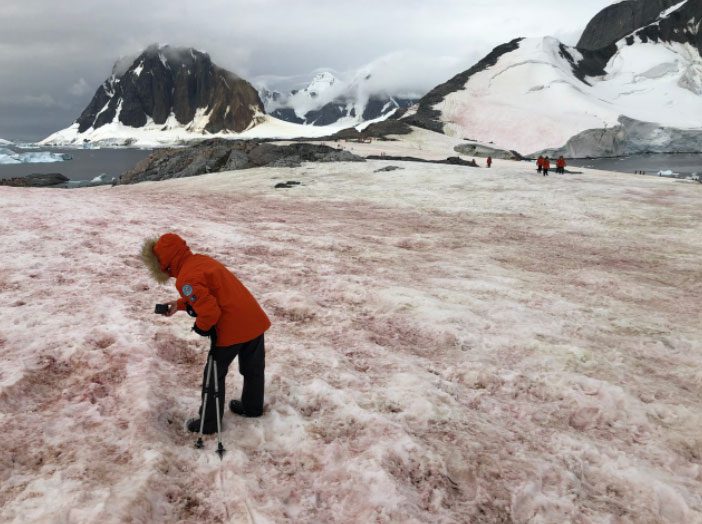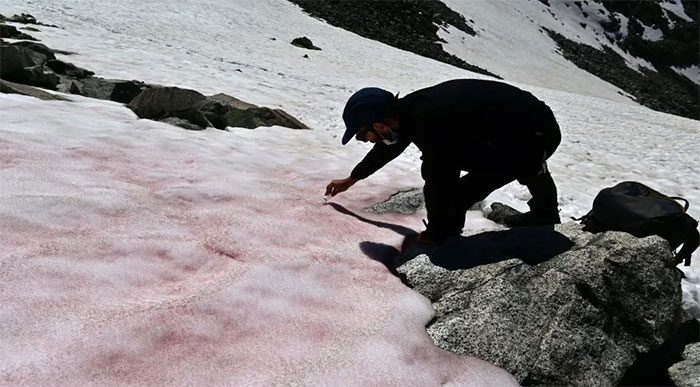In the summer, some snowy regions take on a reddish hue, creating a striking sight known as “watermelon snow.”
“Watermelon snow” is caused by a type of algae that contains a red pigment. The most common type is Chlamydomonas nivalis, a green algae that contains carotenoid, a substance that gives it a carrot-like red color.

Pink snow on the Alps in 2021 – (Photo: NEW YORK TIMES)
The unique feature of Chlamydomonas nivalis compared to other freshwater algae is its preference for cold environments. Chlamydomonas nivalis thrives in icy conditions.
The cell walls of the algae are very thick, acting as a “thermal shield.” This allows the algae to survive in environments as cold as minus 40 degrees Celsius.
However, extremely cold weather can also inhibit the algae’s activity. In other words, the algae seem to go into a state of “dormancy.”
The peak growing season for Chlamydomonas nivalis is in the summer, when the weather becomes less harsh. Additionally, as the layers of ice and snow gradually melt in summer, the red color of the algae becomes more pronounced.
The deeper the red hue, the stronger the algae’s proliferation. In some areas, the snow and ice colored by Chlamydomonas nivalis resemble bloodstains.

Watermelon snow in Antarctica in April – (Photo: ATLAS OBSCURA)
The most common place to encounter “watermelon snow” on Earth is Antarctica. Starting in late April to early May each year, the surface of many layers of snow and ice in Antarctica intriguingly turns red.
Following that are high mountain regions or areas near the Arctic where snow and ice still persist during summer.
Every summer, some areas in the Alps in Europe, the Himalayas in Asia, or the Andes in South America also often turn red. In recent years, many people eagerly await this fascinating phenomenon to capture photographs.
The cellular fluid of Chlamydomonas nivalis often contains sugars and oils, so if you accidentally “taste” the “watermelon snow,” you will find it quite sweet.

“Watermelon snow” on the Alps – (Photo: CNBC)
According to the scientific journal Science, the algae responsible for the “watermelon snow” phenomenon are generally harmless to the ecosystem, as they typically thrive in cold, low-biodiversity areas.
However, the spread of Chlamydomonas nivalis indicates that in regions covered by snow year-round, more ice has melted during the summer. This also means that Earth’s temperatures during the summer months have significantly increased.
Notably, in the northern and southern polar regions, the rise in temperature is currently at the highest levels globally, with an estimated increase three times the global average.
Many experts also express concern that when the ice is covered in red algae, the underlying ice loses its ability to reflect sunlight, which could accelerate the melting of the ice.

















































